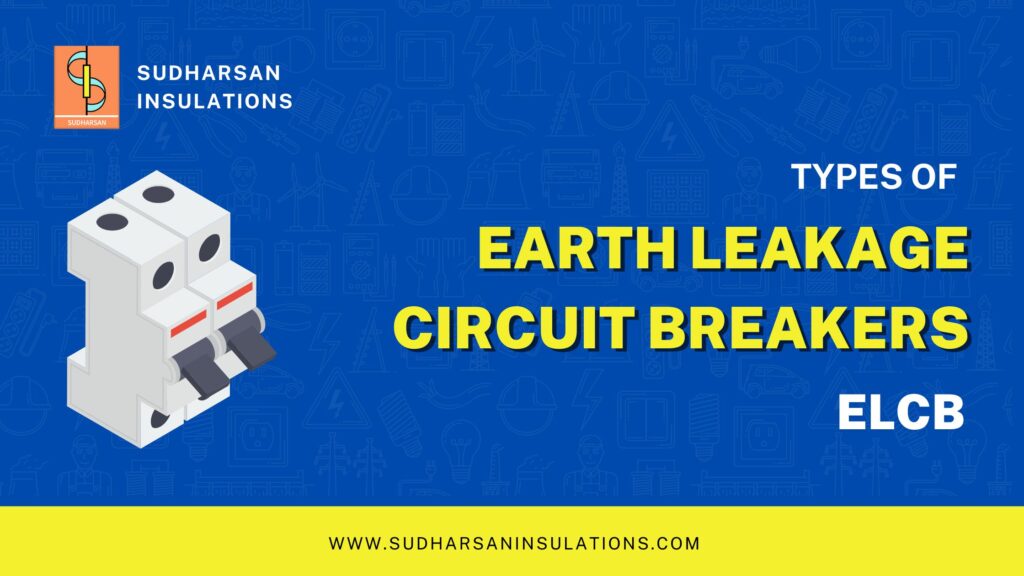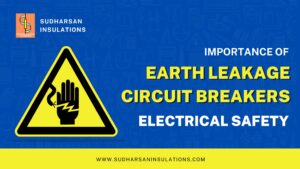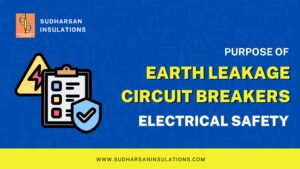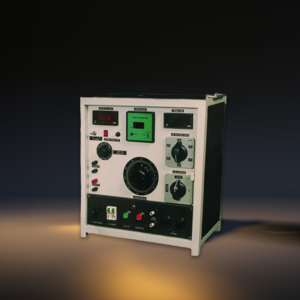Types of Earth Leakage Circuit Breakers Explained
Last Updated : May 13, 2024

Ensuring electrical safety is crucial in any residential, commercial or industrial setting. One of the most important protective devices in this regard is the earth leakage circuit breaker (ELCB), also known as a residual current circuit breaker (RCCB).
These specialized breakers are designed to quickly detect and interrupt ground fault currents, preventing electrocution and fire hazards. However, not all ELCBs are created equal – there are different types suited for various applications.
In this comprehensive guide, we’ll explore the main categories and what distinguishes one ELCB type from another.
We at Sudharsan Insulations will delve into the importance of ELCB for home safety, provide essential information on its installation and maintenance, and equip you with the knowledge to safeguard your living space and loved ones from the dangers of electrical malfunctions. It is turning out to be of utmost importance to ensure electrical security inside our houses so that our health and property is properly safeguarded. To complete this task the Earth Leakage Circuit Breaker (ELCB) is the major point.
Understanding Earth Leakage Circuit Breakers (ELCB/RCCB)
Before diving into the types, let’s first understand what an ELCB is and how it functions. An earth leakage circuit breaker is a safety device that automatically cuts off the electrical supply when it detects an insulation failure or leakage current to earth that exceeds a predetermined value, typically 30mA.
The basic operating principle is quite simple:
1. The live and neutral conductors carry the same amount of current in a properly functioning circuit.
2. If there is an insulation fault or leakage path, some current will travel to earth instead of returning through the neutral.
3. The ELCB has a sensor that measures the difference between the live and neutral currents.
4. If this difference exceeds the rated tripping current, the ELCB trips and cuts off power to prevent further leakage.
By quickly responding to earth faults, ELCBs provide shock protection to people who may come into contact with a live part. They also help prevent electrical fires caused by leakage currents and earth faults.
Most electrical codes and regulations mandate the use of ELCBs in certain situations
- Circuits supplying socket outlets rated up to 32A.
- Electrical installations in bathrooms, laundry rooms, kitchens.
- Outdoor installations and construction sites.
- Industrial machinery and locations with high moisture/humidity.
So why are there different ELCB types? The key reasons are varying application requirements, voltages, current ratings, and performance criteria.
The Main Types of ELCBs
While all ELCBs serve the same core function of earth leakage protection, they can be categorized based on several factors:
- Voltage Rating: Low voltage vs high voltage handling capability.
- Number of Poles/Phases: Single pole, double pole, triple pole, four pole.
- Leakage Current Rating: Standard ratings like 30mA, 100mA, 300mA etc.
- Current Type: Alternating Current (AC) vs Direct Current (DC) detection.
Let’s look at the main sub-types in more detail:
AC ELCBs
The most common ELCBs are designed to detect leakage in AC sinewave circuits and systems. Based on the number of poles/phases, they are available as:
- 2-Pole AC ELCBs Low voltage vs high voltage handling capability.
- 3-Pole AC ELCBs: Single pole, double pole, triple pole, four pole.
- 4-Pole AC ELCBs: Standard ratings like 30mA, 100mA, 300mA etc.
AC ELCBs from reputable brands are suitable for most general residential, commercial and light industrial applications running on AC power. They offer reliable protection against earth faults for the connected loads and circuits.
DC ELCBs
While conventional ELCBs can detect leakage in AC sinewave currents, they do not function properly with DC circuits and loads. This is where DC ELCBs come into play. These are designed to identify earth faults and trip during:
- DC power output from solar photovoltaic systems.
- Battery banks and uninterrupted power supplies (UPS).
- DC motor drives, inverters and controllers.
- Electrolytic processes and other DC industrial applications.
The operating principles are similar to AC types, but the sensing mechanisms are optimized to detect smooth DC leakage currents instead of AC sinewave earth faults.
ELCBs by Voltage Rating
Both AC and DC ELCBs are further classified based on their voltage rating and insulation capability:
| Voltage Rating | Applications |
|---|---|
| Low Voltage (≤ 1000V AC/1500V DC) | Residential, commercial, light industrial |
| Medium Voltage (≤ 7200V AC) | Industrial machinery, larger power systems |
| High Voltage (≥ 7200V AC) | Power transmission, heavy industry |
It’s crucial to use an ELCB rated for the maximum voltage present in the circuit or application. Using a low voltage breaker on a medium or high voltage circuit would compromise protection and violate safety standards.
ELCBs by Leakage Current Ratin
Another way to distinguish ELCBs is by their rated leakage tripping current. This specifies the maximum fault current they can detect before interrupting the circuit. Some common leakage current ratings are:
- 30mA: The standard rating, suitable for most residential/commercial applications with increased sensitivity.
- 100mA: Used where a 30mA rating may cause nuisance tripping, like some industrial setups.
- 300mA: For equipment/locations with high leakage currents in normal use.
- 500mA or higher: Specialized industrial applications like computing centers, HVAC systems, etc.
The leakage current rating is chosen based on the application, connected loads, and level of personnel protection required as per standards and safety considerations.
Selecting the Right ELCB Type
With so many different types and variations available, selecting the appropriate ELCB can seem daunting. Here are some key factors to consider:
1. Supply Voltage: Match the ELCB voltage rating to the maximum circuit/system voltage.
2. AC or DC: Use AC types for alternating current circuits and DC types for DC supplies/solar.
3. Number of Poles/Phases: Single pole for single phase, two/three/four pole for multi-phase supplies.
4. Leakage Current Rating: Based on the application’s earth leakage risk, safety standards and permissible leakage.
5. Application: Residential, commercial or industrial use? Dry or damp/wet conditions? Motor loads
It’s also important to use ELCBs in conjunction with other protective devices like circuit breakers and surge arrestors for comprehensive electrical safety.
Most residential installations can be adequately protected using 2-pole, 30mA AC ELCBs on single phase circuits rated up to 240V. However, industrial and specialized applications must carefully evaluate ELCB specifications against their unique operating conditions and electrical codes.
Installing and Testing ELCBs
Proper installation following the manufacturer’s instructions is crucial for ELCBs to function as intended. Here are some general guidelines:
1. Correct Supply Connections: Double check the supply lines are connected to the appropriate line and neutral terminals.
2. Earthing: Ensure the ELCB earthing terminal is bonded to electrical ground.
3. Accessories: Install any required accessories like shunt trips or undervoltage releases.
4. Leakage Current Rating: Based on the application’s earth leakage risk, safety standards and permissible leakage.
5. Labelling: Clearly label or identify the ELCB for the circuit it is protecting.
Regular testing of the ELCB’s tripping mechanism is also essential to verify it will operate correctly when needed. Most models have a “Test” button that injects a simulated leakage to trip the breaker.
If an ELCB fails to trip during testing, it should be replaced immediately as it may not provide protection in a real ground fault situation. ELCBs generally have a service life of 10-20 years depending on operating conditions.
Here’s the continuation of the blog post:
Trusted ELCB Manufacturers and Models
When it comes to electrical safety devices like ELCBs, you want to choose quality products from reputable manufacturers who follow rigorous testing and compliance standards. Some of the most trusted brands include:
- Schneider Electric: Models like the Acti9 Asi range, compact iRCCBs, Vigi range.
- ABB: F and F Compact Series ELCBs, DSN range of DC breakers.
- Siemens: 5SM3 and 5SV3 ELCBs across AC/DC, various leakage ratings.
- Legrand: DX3 ELCBs, RCCBs for commercial and industrial applications.
- Eaton: PF range of ELCBs, DC breakers for solar/UPS applications.
- Havells: Reasonably priced ELCBs for residential and light commercial use
When evaluating ELCB models, look for key certifications like IEC, EN, UL listings which indicate they meet stringent performance and safety criteria. Higher short circuit withstand capabilities and robust construction are desirable for industrial environments.
It’s also a good practice to select ELCBs from the same manufacturer as your other electrical distribution equipment like circuit breakers and panels. This ensures consistent performance and easier integration.
Conclusion
Selecting and installing the correct type of earth leakage circuit breaker is vitally important for electrical shock protection and preventing hazardous situations. As we explored, ELCBs come in different varieties based on voltage, current type, leakage rating and number of poles.
For residential and small commercial installations, 2-pole 30mA AC ELCBs on single phase circuits usually suffice. However, larger scale industrial projects, DC power systems like solar PV, and specialized applications require a careful evaluation of ELCB specifications and coordination with other protective devices.
By understanding the key differences between ELCB types, you can ensure your electrical setup meets all safety standards and code requirements. Don’t hesitate to consult licensed professionals and refer to manufacturer guidelines whenspecifying and installing these critical safety components.
Other Products from Sudharsan Insulation are
High Voltage Kits, Loading Transformers, Primary Current Injection Test Kit, Secondary Injection Kits, MCCB Kits, RCCB Kits.




